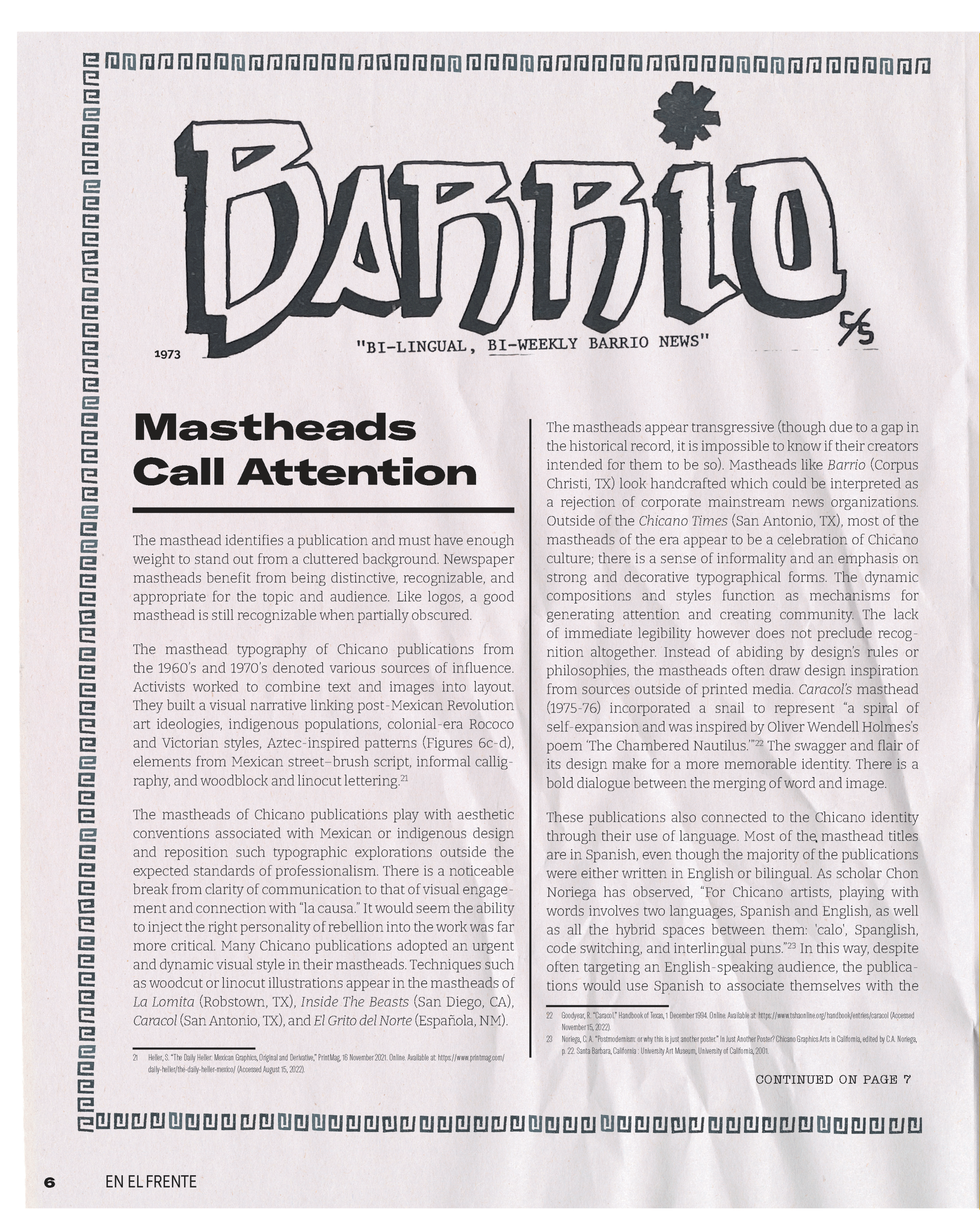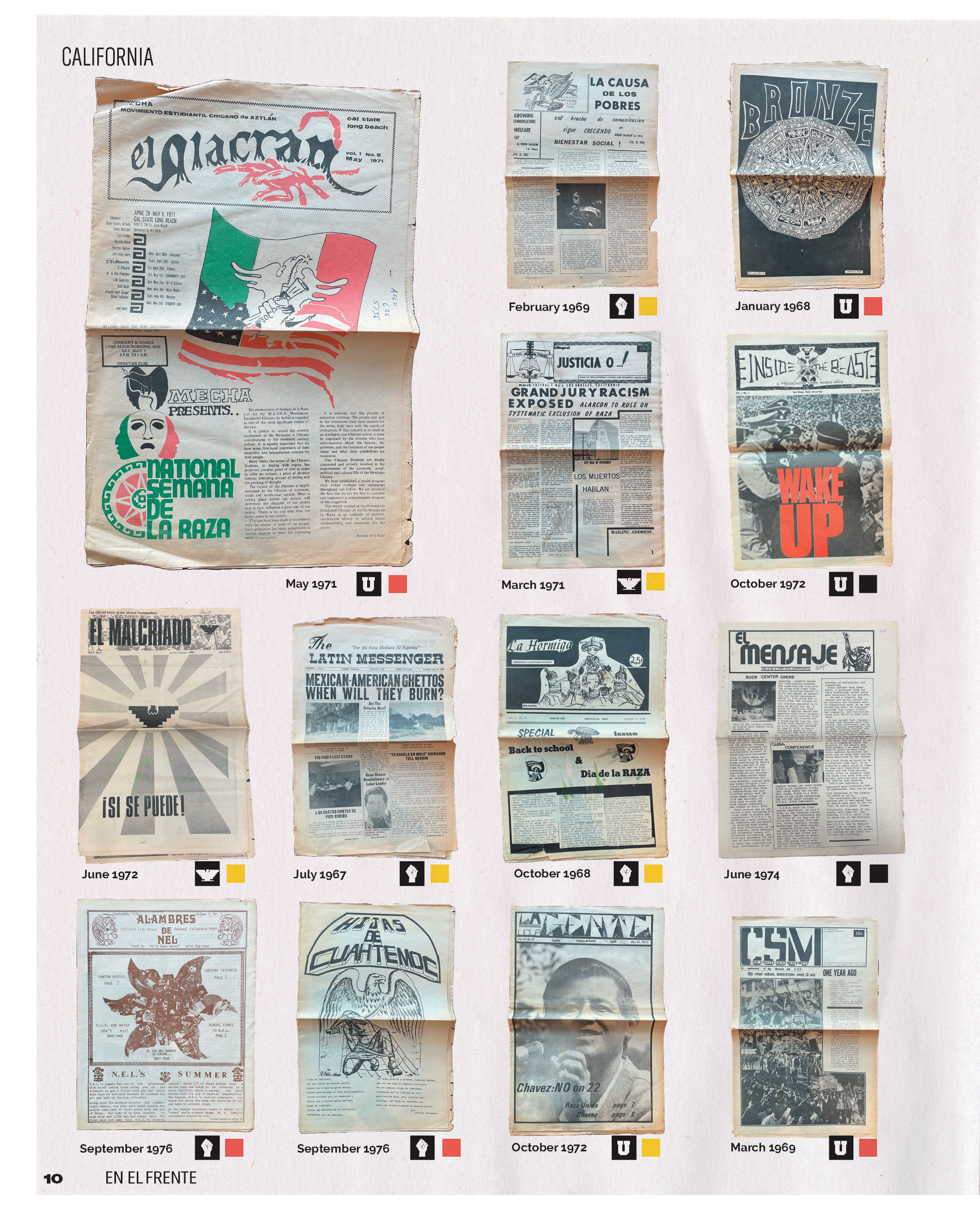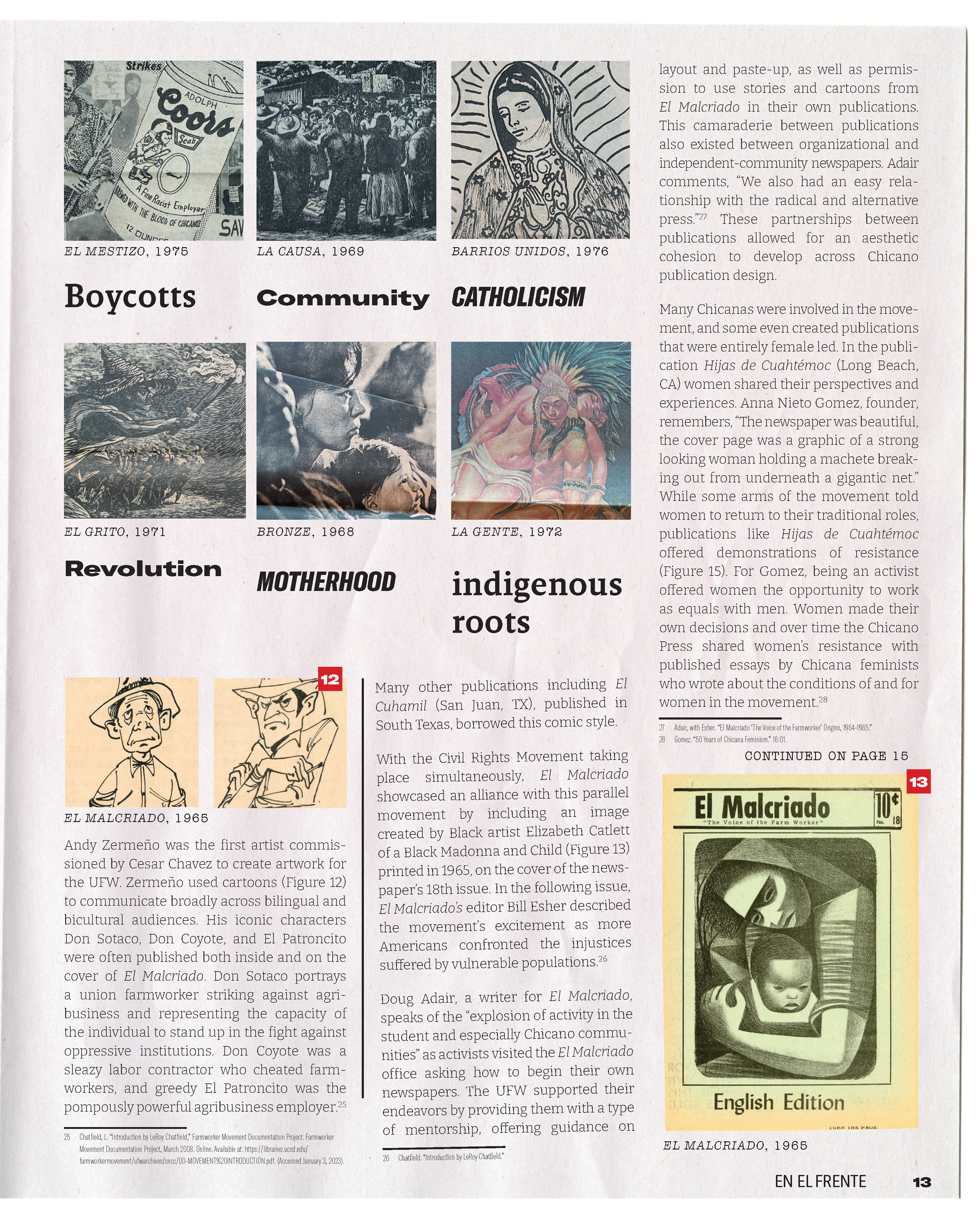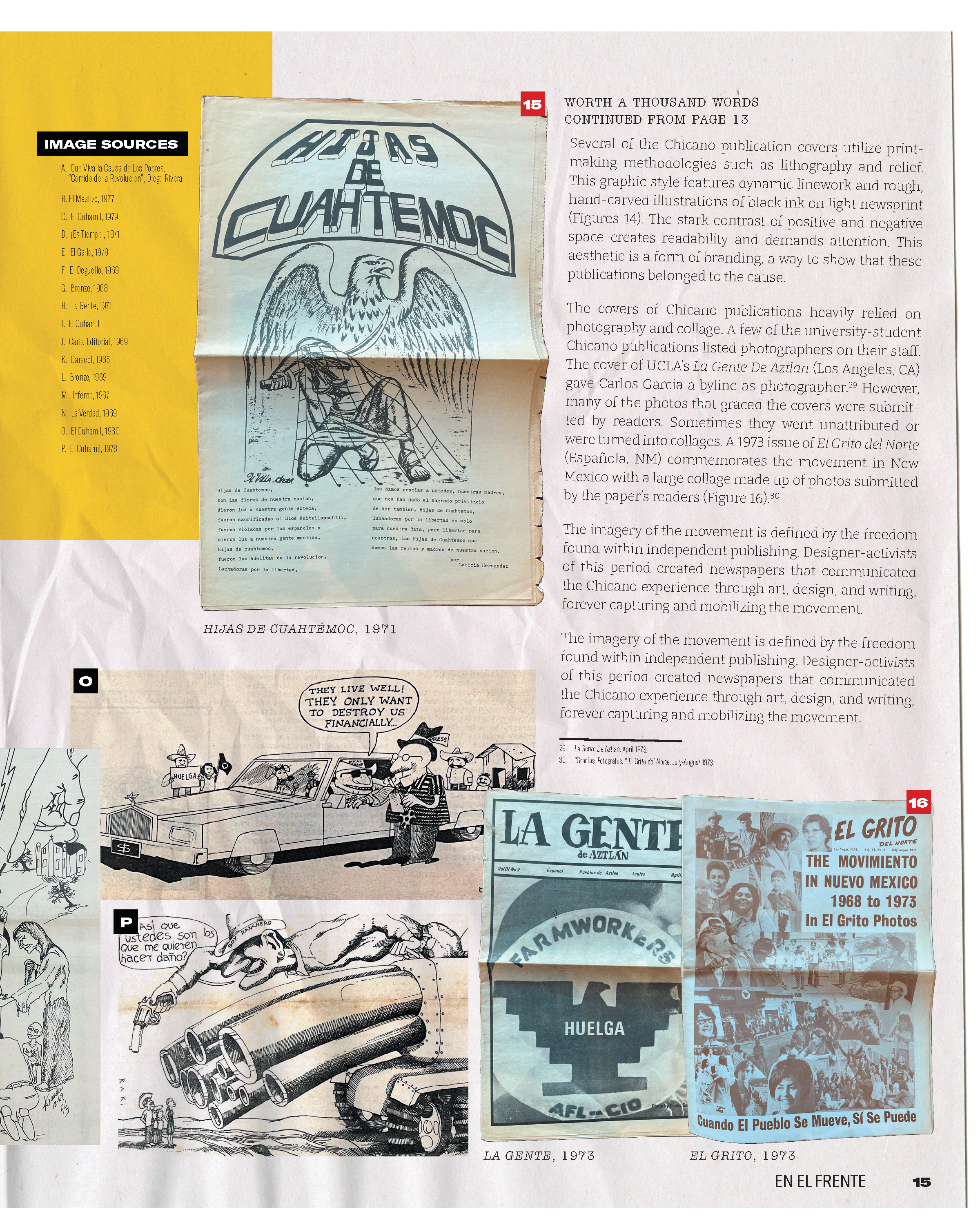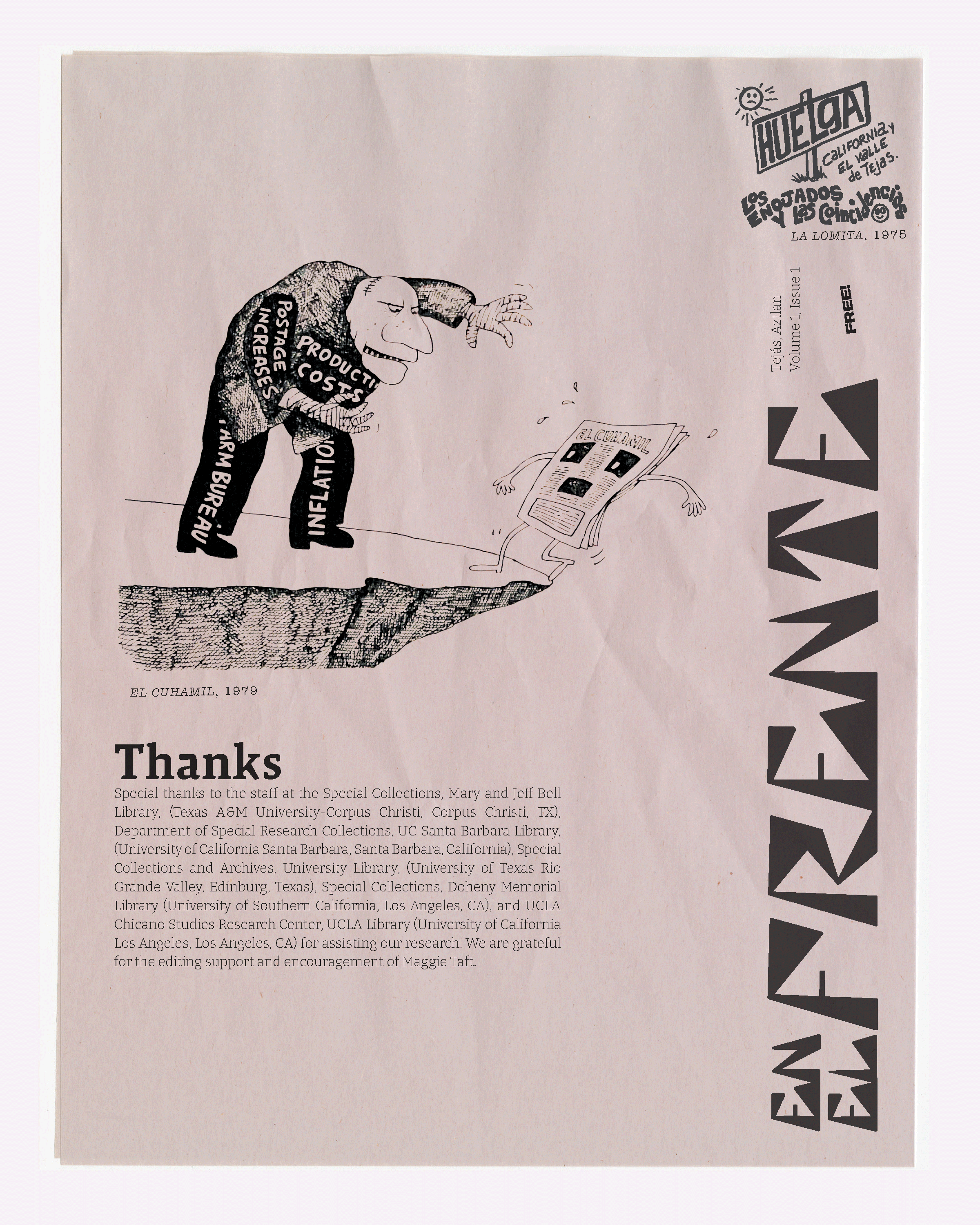A Contextual Analysis of the Front Covers of Chicano Independent Publications
The turbulent economic, political, and societal unrest that shook many areas in the U.S. during the 1960s and 1970s fueled the cultural conditions necessary to facilitate the activation of the group that evolved into the radical minority Chicano movement (or El Movimiento), as well as the rise of movements and campaigns for social justice that were facilitated by other parallel American political and socio-cultural groups. These included but were not limited to Black Power, women’s liberation, and gay rights. 7 The Chicano movement was an initial attempt to shape a unified ideology that served the interests of the Mexican American working class. 8 Independent publications written, designed, and distributed by Chicanos served as important engines that guided and drove the construction and sustenance of the Chicano movement. They proved to be instrumental in helping Chicanos establish communities and helped define both their collective and more localized identities. These publications proved to become, in the words of one scholar, the “primary educational tool and propaganda [vehicles that supported]… the movement,” and helped to articulate a definition for what it meant to be Chicano. 9 They recorded and critically analyzed the injustices and violence faced by Chicano communities across the U.S., and issued and promoted calls for Chicano workers to unionize, boycott products, and march in demonstrations as ways of organizing and advocating for social justice. 10 This visual essay and the narrative that accompanies it explores and examines how various aspects of their graphic design work supported their missions.
The authors began their endeavor by visiting the Special Collections archives at the Texas A&M University-Corpus Christi, the University of Texas Rio Grande Valley, the University of California at Santa Barbara, the University of Southern California, and the University of California at Los Angeles. Each of these Special Collections housed editions of independent Chicano publications that had been published in the 1960s and 1970s in California and Texas. Both of these states were hubs of several organizations that were integral to the development and sustenance of the Chicano movement and the social, economic, and political activism that it guided and fueled during the 1960s and 1970s. 11 These archives house the corpus of Chicano independent publications that were written, designed, and distributed in the U.S. during this time. Critically assessing the graphic design of these publications, which also involved comparing and contrasting the different thematic and aesthetic approaches that were undertaken by their designers, would have been difficult-to-impossible without being able to see and contemplate their wide variety firsthand, as many of them have not been digitized. Analyzing them has the potential to reveal new design knowledge and understandings, which could not have been shared without this undertaking. This process of studying these publications within these archives, and particularly the designs of their covers, and then compiling and curating a collection from among them to understand and expand the historical canon to include the work of Chicano designers and authors is akin to that of other contemporary research projects such as Gráfica Latina and The People’s Graphic Design Archive. 12
As the 1960s progressed and newly improved offset printing processes made the printing of a broad array of publications more affordable, the production and distribution of independent publications across the U.S. (and much of the rest of the so-called developed world) became much more widespread. 13 Within the American Chicano community, the number of publications grew rapidly, from less than 10 at the end of 1964 to more than a hundred by the end of 1969. 14 There was great diversity among these publications, which included newspapers published by non-governmental organizations, such as The United Farm Workers’ El Malcriado (The Spoiled One) and The Texas Farm Workers’ Union El Cuhamil, the Brown Beret’s La Causa (The Cause) and Regeneración (Regeneration), as well as newspapers published by independent community publishers, such as Caracol (Snail), which was published in San Antonio, Texas and El Grito del Norte (The Cry of the North), which was published in Denver, Colorado, and independent publications produced by university students, such as ucla’s La Gente (The People). The Chicano Press Association was created by activists in 1969 to serve as an internal organ of communications between these publications and their readerships by sharing a given community’s local stories about history, literature, and news-based concerns with other Chicano publications across the U.S. 15 This helped this diverse but philosophically united group of publications maintain consistent communications and helped galvanize support for the Chicano cause across the country. 16
These publications strove to give voice to the issues that mattered most to American Chicanos during this time, covering politics, labor rights, economic, and social justice concerns to counter and correct much of the disinformation disseminated in many American mass media portrayals of the Mexican American experience, or to supplement a lack of information about it that was then all-too-prevalent in the traditional, mostly white-controlled American media of the time. 17 These publications were an important, and, in some American locations, the only means for Chicano audiences to gain information about, much less interact with, the Chicano movement.
Chicano newspapers were typically distributed on urban street corners, where they were stacked in piles for passersby to pick up. To attract reader attention, the newspapers that comprised the Chicano Press often adopted popular American underground press cover styles of the day that incorporated compositional approaches such as the use of photographic collage and simple line drawings to communicate ideas of outrage, protest, rebellion, and freedom. They also incorporated several distinctive visual elements into these designs that, as the 1960s gave way to the 1970s, became recognizable as some of the key components and motifs inherent in the visual identity that sought to communicate the core ideas that informed the Chicano movement. These components and motifs can be seen throughout the array of Chicano press newspaper covers that are depicted within this visual narrative, such as imagery that represents or is derivative of Aztec, Mayan, or Olmec art, are deployed within geometrically simple combinations of shapes and linework in asymmetrically balanced compositions. By incorporating art and design work that was socio-culturally significant and relevant to their Chicano target audiences, the designers of many of the Chicano press newspapers were able to visually communicate messaging that helped mobilize these historically underrepresented groups toward social, political, and economic action. 18
The En El Frente (“On The Front”) visual narrative has been designed to function as its own independent Chicano publication. The authors seek to engage and enlighten the audiences for our work and the readers of this piece by emulating the front pages of historic Chicano newspapers. In each section of the visual essay, the authors imitate important elements of editorial design and analyze design decisions made by Chicano activists and activist designers to make the techniques visible to readers. We employ the unique visual style of those publications in our work by incorporating iconography rooted in Mexican and Mexican American art and design work, as well as bold phrases that were featured in posters of the Mexican revolutionary period (November 20, 1910–February 5, 1917). Like the Chicano activists, the use of iconography in this visual essay creates a conceptual and historical connection to the ongoing fight for social justice that historically faced the Mexican people. The visual connection to the Mexican Revolution of 1910 and the figures of Pancho Villa, Emiliano Zapata, and La Adelina empowered and unified the Chicano movement by emphasizing references to the revolutionary heritage of many Mexican American people. 19 Like the Mexican Revolution, the Chicano movement strove to empower the poor and the working class by advocating for, and, in some instances, directly or indirectly implementing social and political reforms. 20 Additionally, the authors make use of printing methods and imagery that art historians Charlotte Benton, Tim Benton and Ghislaine Wood refer to as “Aztec-inspired art deco,” 21 a genre of art and architecture that employs heavily stylized, geometrically basic, block-printing techniques, as well as the incorporation of syncopated patterns comprised of abstract forms. 22 Examples of this can be seen in the visual essay En El Frente’s masthead (page 1), and in the decorative page borders (pages 2, 4–6) as well as in the 1971 and 1972 versions of front covers of La Gente (page 9). 23
As we navigate our present moments of civil and societal unrest in the United States, and the ongoing fight for social justice that has and continues to accompany it, revisiting parallel moments in American history provides an opportunity to learn from how and why past designers devised the visual communication strategies that they did, and then created and disseminated work guided by these to promote and foment advocacy and activism. Many current cultural, social, technological, economic, and political issues that affect the lives of Latinx communities in the U.S., such as working in unsafe conditions, earning non-livable wages, and having to deal with immigration insecurity and police violence, bear striking resemblance to the labor strikes, deportation policies, police violence, and lack of equitable education occurring in many areas of the U.S. during the 1960s and 1970s that inspired the Chicano movement. The authors hope that this critical examination of the visual languages, imagery, and compositional structures employed across the design of many independent American Chicano newspapers published during the late 20th century encourages contemporary designers, historians, and design students to consider the power of community-focused publications to facilitate positive action and social change. Whether the intent is to provide a means to alter undesirable sets of circumstances or as a means to engage and support contemporary design practice, gaining a deeper understanding of the design decision-making that guided the development of this work has the potential to yield new design work that is relevant and actionable.
The increasing disappearance of community-run newspapers —whether this occurs in the U.S. or anywhere else in the world, and whether these appear in print or as online entities—results not only in less-well-informed societies, but in the creation of an information vacuum that, especially since the widespread advent of social media, tends to be filled with mis- and dis-information. 24 Social media platforms allow for individuals to report their often myopically informed, not deeply considered opinions on local levels and these platforms utilize algorithms that control the visibility of certain types of content, and, “can modify patterns of individual exposure in opaque ways, often prioritizing content that provokes extreme reactions from users.” 25 In other words, these algorithms can and do limit what many social media users see and read within narrowly confined realms of content and context. The gradual consolidation of news companies over the past 20 or so years has left many American communities without the ability to add their critical perspectives to the often singularly biased, white-majority national news stories that have become prevalent across the U.S. The effect of not reporting, much less analyzing, locally sourced and relevant information is felt widely in the United States and has resulted in the kinds of societal polarity that exacerbates issues such as immigration, labor rights, policing, and responses to the Covid-19 pandemic.
In closing, the authors advocate for contemporary designers in the U.S., along with design researchers, scholars, historians, and students, to look to the designer activists that helmed the independent Chicano publications that were published in the 1960s and 1970s for cues regarding how they might effectively advocate for social, economic, and political justice. A few examples of independent publications from contemporary designer-activists or organizations are described as follows.
Isabel Ann Castro, co-founder of St. Sucia, a contemporary Latina/x feminist magazine based in San Antonio, Texas from 2014 to 2018 that covered topics such as reproductive justice, education, gender identity, and immigration, used this publication to describe her experiences of creating a contemporary publication as a continuation of the independent Chicano publications that operated in the U.S. in the 1960s and 1970s. 26
Guadalupe Pardo is a south Texas-based Latinx designer and artist who began producing the zine The History of Policing in the Rio Grande Valley in 2019, which makes use of archival material from independent Chicano publications from the 1960s and 1970s to help frame and inform their examination of the history of abusive policing in Texas’ Rio Grande Valley. 27
Latinx artist Julia Arrendondo writes about her experiences involving the independent publishing of zines such as Guide to Being Broke and Fabulous, Guide to Being Alone, Easy Magic, and Baltimore Break-ups: A Pop-Up Memoir, as “a practice of empowerment… sharing iconography/narratives that attract like-minded individuals… when no other platforms were available for support.” 28
Sherwood Forest Zine Library in Austin, TX, usa holds an archive of work by contemporary artists and designers who have produced independent publications exploring topics such as labor movements, activism, and other grassroots efforts that have paralleled the content that was published in independent Chicano publications across the U.S. from the 1960s and 1970s. 29
Contemporary iterations of these types of publications continue to empower local communication from activist-designers who communicate directly with their communities, and who provide valuable information concerning their collective well-being and assistance as they advocate for social, political, and economic justice. They, and the independent Chicano publications that appeared in the U.S. during the 1960s and 1970s that preceded them, can serve as inspirations for contemporary designers, students, researchers, scholars, and historians who seek to address and combat disinformation and injustice both within contemporary Latinx communities and beyond them.
Visual Essay Image Citations
Chicano Newspapers, 1970, Collection 42, Box 3, 7, Dr. Leonardo Carrillo Papers, Special Collections and Archives, Mary and Jeff Bell Library, Texas A&M University-Corpus Christi, Corpus Christi, Texas.
Chicano Newspapers, 1962-1986, Collection 118, Boxes 1-5, Johnson-Bezdek Collection on Opposition Politics in Twentieth-Century Mexico, Special Collections and Archives, Mary and Jeff Bell Library, Texas A&M University-Corpus Christi, Corpus Christi, Texas.
Chicano Newspapers, 1970-1980, Collection 116, Boxes 1-5, Judge and Mrs. Lorenzo Rojas Papers, Special Collections and Archives, Mary and Jeff Bell Library, Texas A&M University-Corpus Christi, Corpus Christi, Texas.
Chicano Newspapers, 1970-1980, CEMA 80, Boxes 1-4, Chicano Movement Newspaper Collection, Department of Special Research Collections, UC Santa Barbara Library, UC Santa Barbara, Santa Barbara, California.
Chicano Newspapers, 1962-1986, Boxes A1-A195, Chicano Historical Newspaper Collection, Chicano Studies Research Center Library, UCLA Library, UC Los Angeles, Los Angeles, California.
Cuhamil, 1975-1978, Edinburg Chicano Collection 116, Boxes 1-2, Texas Farm Workers Union, Special Collections and Archives, University Library, University of Texas Rio Grande Valley, Edinburg, Texas.
“El Gallo.” 1968, Emanuel Martinez Collection, Visual Resources Center, Department of Art and Art History, University of Colorado Boulder. Boulder, Colorado. https://aahvrc.colorado.edu/luna/servlet/detail/ArtArtHi%7E4%7E4%7E490%7E130049:El-Gallo--First-Chicano-in-Southwest (Accessed 20 April 2022).
“Farmworker Movement Documentation Project.” Archives Farmworker Movement Documentation Project - primary source accounts by the UFW volunteers. UC San Diego Library. Online. Available at: https://libraries.ucsd.edu/farmworkermovement/archives/#malcriado (Accessed 10 April 2022).
JSTOR. “Independent Voices, Latino,” June 2018. https://www.jstor.org/site/reveal-digital/independent-voices/latino/ (Accessed 10 February 2023).
Notes
- Grigg, Jenny. “Materials and Tools as Catalysts of Invention in 1 McBirney, J. “The Chicano Movement,” CommonLit, 15 May 2017. Online. Available at: https://www.commonlit.org/en/texts/the-chicano-movement (Accessed March 25, 2023). ⮭
- Ramos, E.C. “Notes to the Reader,” ¡Printing The Revolution! The Rise And Impact Of Chicano Graphics, 1965–Now, edited by E. C. Ramos. Washington, D.C., Princeton, NJ, USA: Smithsonian American Art Museum, in association with Princeton University Press, 2020: pgs. 6-7. ⮭
- McMillian, J. C. Smoking Typewriters: The Sixties Underground Press and the Rise of Alternative Media in America. New York: Oxford University Press, 2011: p. 3. ⮭
- Andrade, F. M. “The History of ‘La Raza’ Newspaper and Magazine, and its Role in the Chicano Community from 1967-1977.” PhD diss., California State University, Fullerton, 1979: p. 19. ⮭
- Andrade, F. M. “The History of ‘La Raza’ Newspaper and Magazine, and its Role in the Chicano Community from 1967-1977:” p. 5. ⮭
- Estrada, J. “Chicano Movements: A Geographic History,” Mapping American Social Movements Through the 20th Century. Online. Available at: https://depts.washington.edu/moves/Chicano_geography.shtml (Accessed April 5, 2022). ⮭
- Estrada, J. “Chicano Movements: A Geographic History.” ⮭
- Muñoz, C. Youth, Identity, Power: The Chicano Movement. London, UK: Verso, 2007: p. 26. ⮭
- Rodriguez, M. S. Rethinking the Chicano Movement. New York, NY, USA: Routledge, 2015: p. 117. ⮭
- Ramos, E.C. “Printing and Collecting the Revolution, The Rise and Impact of Chicano Graphics,” ¡Printing The Revolution! The Rise And Impact Of Chicano Graphics, 1965-Now, edited by E. C. Ramos Washington, D.C., Princeton, NJ, USA: Smithsonian American Art Museum, in association with Princeton University Press, 2020: pgs. 24-25. ⮭
- Institutional archives visited: Special Collections and Archives, Mary and Jeff Bell Library, Texas A&M University-Corpus Christi, Corpus Christi, Texas; Department of Special Research Collections, UC Santa Barbara Library, UC Santa Barbara, Santa Barbara, California; Special Collections and Archives, University Library, University of Texas Rio Grande Valley, Edinburg, Texas; Institute of American Cultures, Chicano Research Center Collections, University of California, Los Angeles, Los Angeles, California; Special Collections, USC Libraries, Chicano and Latino Studies, University of Southern California, Los Angeles, California. ⮭
- Menéndez, J. & Gaggero, T. G. “Grafica Latina, About,” Grafica Latina. Online. Available at: https://graficalatina.com/ (Accessed December 13, 2021); Horne, B., Levit, B., Sandhaus, L., and Searcy, M. eds. “About: People’s Graphic Design Archive,” People’s Graphic Design Archive. Online. Available at: https://peoplesgdarchive.org/about (Accessed September 23, 2020). ⮭
- McMillian, J.C. Smoking Typewriters. p. 4. ⮭
- Estrada, J. “Chicano Movements: A Geographic History,” Mapping American Social Movements Through the 20th Century. Online. Available at: https://depts.washington.edu/moves/Chicano_geography.shtml (Accessed April 5, 2022). ⮭
- Rodriguez, E. “Covering the Chicano Movement: Examining Chicano Activism through Chicano, American, African American, and Spanish-Language Periodicals, 1965-1973.” Ph.D. diss., University of California, Riverside, USA, 2013: pgs. 65–66. ⮭
- Rodriguez, E. “Covering the Chicano Movement.” pgs. 7-8; Estrada, J. “Chicano Movements.” ⮭
- Andrade, F. M. “The History of ‘La Raza’ Newspaper and Magazine, and its Role in the Chicano Community from 1967-1977:” pgs. 18–19. ⮭
- Rodriguez, E. “Covering the Chicano Movement:” pgs. 219–220. ⮭
- Garcia, M. T. Chicano Generation–Testimonios of the Movement. Oakland, CA, USA: University Of California Press, 2015: p. 15. ⮭
- Fernandez, J. “Reimagining the Mexican Revolution in the United Farm Workers’ El Malcriado (1965-1966).” MA thesis, University of California, San Diego, 2018: p. 19. ⮭
- Benton, C., Benton, T. & Wood, G. Art Deco, 1910–1930. London, UK: V&A Publications, 2003: pgs. 57–64. ⮭
- Heller, S. “The Daily Heller: Mexican Graphics, Original and Derivative,” PrintMag, 16 November 2021. Online. Available at: https://www.printmag.com/daily-heller/the-daily-heller-mexico/ (Accessed August 15, 2022). ⮭
- Heller, S. “The Daily Heller: Mexican Graphics, Original and Derivative,” PrintMag, 16 November 2021. Online. Available at: https://www.printmag.com/daily-heller/the-daily-heller-mexico/ (Accessed August 15, 2022). ⮭
- Hendrickson, C. “Local Journalism in Crisis: Why America Must Revive Its Local Newsrooms,” Brookings, 12 November 2019. Online. Available at: https://www.brookings.edu/research/local-journalism-in-crisis-why-america-must-revive-its-local-newsrooms/ (Accessed August 4, 2022). ⮭
- Ardia, D., Ringel, E., Fox, A., & Ekstrand, V.S. “Addressing the Decline of Local News, Rise of Platforms, and Spread of Mis- and Disinformation Online,” Center for Information, Technology, and Public Life (CITAP), UNC Center for Media Law and Policy, University of North Carolina at Chapel Hill, 22 December 2020. Online. Available at: https://citap.unc.edu/local-news-platforms-mis-disinformation/ (Accessed February 15, 2021). ⮭
- Zapata, C. “Don’t Mess with Tejanas: Texan Feminist Artists And Zine Publishing As Resistance,” Hemisphere: Visual Cultures Of The Americas 12 (2019): pgs. 98-104. ⮭
- Pardo, G. “The ‘Animals’ of Mcallen PD - A History of RGV Policing.” Edited by A. Vela and J. Ramirez. Trucha RGV, 29 July 2022. Online. Available at: https://truchargv.com/mcallen-pd/ (Accessed August 15, 2022). ⮭
- Arrendondo, J. “Zines,” Julia Arredondo, 2022. Online. Available at: https://www.juliaarredondo.com/zines (Accessed September 23, 2020). “Striketober/Labor Zines,” Sherwood Forest Zine Library, 5 January 2022. Online. Available at: https://www.sherwoodforestzinelibrary.org/copy-of-black-issues-policing-prote (Accessed July 15, 2022). ⮭
- “Striketober/Labor Zines,” Sherwood Forest Zine Library, 5 January 2022. Online. Available at: https://www.sherwoodforestzinelibrary.org/copy-of-black-issues-policing-prote (Accessed July 15, 2022). ⮭
References
Andrade, F. M.. “The History of ‘La Raza’ Newspaper and Magazine, and its Role in the Chicano Community from 1967-1977.” PhD diss., California State University, Fullerton, 1979.
Ardia, D., Ringel, E., Fox, A., & Ekstrand, V. S.. “Addressing the Decline of Local News, Rise of Platforms, and Spread of Mis- and Disinformation Online.” Center for Information, Technology, and Public Life (citap). UNC Center for Media Law and Policy, University of North Carolina at Chapel Hill, 22 December 2020. Online. Available at: https://citap.unc.edu/local-news-platforms-mis-disinformation/ (Accessed February 15, 2021).
Benton, C., Benton, T. & Wood, G. Art Deco, 1910–1930. London, UK: V&A Publications, 2003.
Arrendondo, J. “Zines.” Julia Arredondo, 2022. Online. Available at: https://www.juliaarredondo.com/zines (Accessed September 23, 2020).
Chavoya, C.O. & Frantz, D. E., with Gómez-Barris, M. Axis Mundo: Queer Networks in Chicano L.A. Los Angeles: ONE National Gay & Lesbian Archives at the USC Libraries, 2017.
Estrada, J. “Chicano Movements: A Geographic History,” Mapping American Social Movements Through the 20th Century. Available at: https://depts.washington.edu/moves/Chicano_geography.shtml (Accessed April 5, 2022).
Farmworker Movement Documentation Project, 2004-2012. Online. Available at: https://libraries.ucsd.edu/farmworkermovement/. (Accessed January 3, 2023).
Fernandez, J. “Reimagining the Mexican Revolution in the United Farm Workers' El Malcriado (1965-1966).” MA thesis, University of California, San Diego, 2018.
Garcia, M. T. Chicano Generation - Testimonios of the Movement. Oakland, CA: University Of California Press, 2015.
Gomez, A.N. “50 Years of Chicana Feminism: Celebrating the Hijas De Cuauhtémoc.” ucla Chicano Studies Research Center. YouTube. 18 November 2021. Available at: https://www.chicano.ucla.edu/events/panel-and-performance-50-years-chicana-feminism-celebrating-hijas-de-cuauht%C3%A9moc. (Accessed September 1, 2022).
Goodyear, R. “Caracol.” Handbook of Texas, 1 December 1994. Online. Available at: https://www.tshaonline.org/handbook/entries/caracol (Accessed November 15, 2022).
Heller, S. “The Daily Heller: Mexican Graphics, Original and Derivative.” PrintMag, 16 November 2021. Online. Available at: https://www.printmag.com/daily-heller/the-daily-heller-mexico/ (Accessed August 15, 2022).
Hendrickson, C. “Local Journalism in Crisis: Why America Must Revive Its Local Newsrooms,” Brookings, 12 November 2019. Online. Available at: https://www.brookings.edu/research/local-journalism-in-crisis-why-america-must-revive-its-local-newsrooms/ (Accessed August 4, 2022).
Horne, B., Levit, B., Sandhaus, L., & Searcy, M. eds. “About: People's Graphic Design Archive.” People's Graphic Design Archive. Online. Available at: https://peoplesgdarchive.org/about (Accessed September 23, 2020).
McBirney, J. “The Chicano Movement,” CommonLit, 15 May 2017. Online. Available at: https://www.commonlit.org/en/texts/the-chicano-movement (Accessed March 25, 2023).
McMillian, J. C. Smoking Typewriters: The Sixties Underground Press and the Rise of Alternative Media in America. New York: Oxford University Press, 2011.
Menédez, J. & Gómez, T. “Grafica Latina, About.” Grafica Latina. Online. Available at: https://graficalatina.com/ (Accessed December 13, 2021).
Muñoz, C. Youth, Identity, Power: The Chicano Movement. London: Verso, 2007.
Noriega, C. A., ed. Just Another Poster?: Chicano Graphic Arts in California = Sólo Un Cartel Más: Artes Gráficas Chicanas En California. Santa Barbara, CA: University Art Museum, 2001.
Pardo, G. “The ‘Animals’ of McAllen pd - A History of rgv Policing.” Edited by A. Vela & J. Ramirez. Trucha rgv, July 29, 2022. https://truchargv.com/mcallen-pd/ (Accessed August 15, 2022).
Ramos, E. C., ed. ¡Printing The Revolution! The Rise And Impact Of Chicano Graphics, 1965-Now. Washington, D.C., Princeton: Smithsonian American Art Museum, in association with Princeton University Press, 2020.
Rodriguez, E. “Covering the Chicano Movement: Examining Chicano Activism through Chicano, American, African American, and Spanish-Language Periodicals, 1965-1973.” PhD diss., University of California, Riverside, 2013.
Rodriguez, M. S. Rethinking the Chicano Movement. New York: Routledge, 2015.
Rueda, C. “Oral History Interview of Carlos Marentes.” South Texas Stories, 9 September 2016. Online. Available at: https://library.tamucc.edu/exhibits/s/sts/item/276 (Accessed September 1, 2022).
Sherwood Forest Zine Library, “Striketober/Labor Zines.” 5 January 2022. Online. Available at: https://www.sherwoodforestzinelibrary.org/copy-of-black-issues-policing-prote (Accessed July 15, 2022).
Zapata, C. "Don’t Mess with Tejanas: Texan Feminist Artists and Zine Publishing As Resistance." Hemisphere: Visual Cultures of The Americas, 12.1 (2019).
Zapata, C. “Branding ‘Death’ In A High-Tech Boycott: United Farm Workers and The Wrath Of Grapes Campaign.” Jollas: Journal of Latino/Latin American Studies, 10.1 (2019).
Biography
Alexandria Canchola designs, illustrates, and creates immersive large-scale installations that are inspired by personal and socio-culturally informed narratives, explorations of diverse color palettes, experimentations with letterforms, and filmmaking. Her idiosyncratic approach to design stems from her desire to empower diverse groups of people and individuals, and make a positive difference in their lives by crafting and disseminating engaging and meaningful design and artwork. She has fulfilled many creative and design-rooted roles on behalf of publications, small businesses, and non-profits as she striven to synthesize their original, creative ideas with hers.
Alexandria has a Bachelor of Arts from University of Texas at Austin, and an mfa in 2D Design from University of Texas Rio Grande Valley. She is an Assistant Professor at Texas A&M University–Corpus Christi who eagerly working to assist her students in their quest to construct and acquire knowledge so they may fully understand the power they wield as designers in communicating ideas that have the potential to instigate and sustain positive change. She can be reached via email at: alexandria.canchola@tamucc.edu
Joshua Duttweiler is a designer, artist, and educator. His multi-disciplinary practice encompasses personal, collaborative, and client-based projects that are focused on social justice and community building. Largely inspired by his ever-changing locations, his work is a critical exploration of historical and present-day societal systems and constructs. Joshua asks his audiences to consider the spaces they occupy from a wide variety of perspectives as means to allow them to hear and respond to new voices.
Joshua holds an mfa in Graphic Design from Boston University in Boston, Massachusetts, U.S.A. He regularly exhibits and curates work nationally and internationally. He currently resides in Corpus Christi, Texas where he is an Assistant Professor at Texas A&M University–Corpus Christi. As an educator, he seeks to empower his students to positively change the world with their empathetically informed, original ideas for creating visual communications, systems, and services. He can be reached via email at: joshua.duttweiler@tamucc.edu






